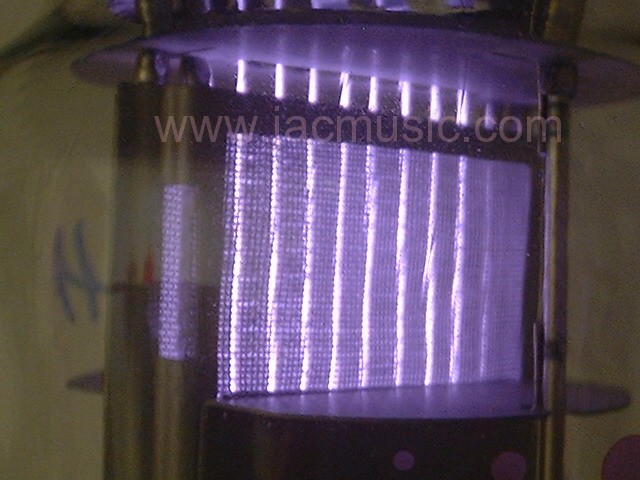Since 1993 Copyright Notice
BLUE GLOW IN ELECTRON TUBES
Welcome to the blue glow pages! You probably landed here by coincidence, but we know from our web statistics that this is one of the most visited pages.
We started the this BLUE GLOW page actually only to explain some things people ask about, in relation with the Emission Labs tubes we make in our own factory. Now the page has grown and grown... If you have some new information or nice pictures, please send those. Thank you!
Just one final word, most people think they have bad "gassy" tubes when the see blue effects, but actually blue effects of gas is hardly visible. Even so, this is quite rare. In almost all cases we have to do with blue fluorescent light effects. These are much brighter, have totally another cause, are no problem at all, and are just nice to see in the dark.
Please do not copy the text from this page, but we much appreciate a link with source. Thank you :)
Long before vacuum tubes were discovered as electronic devices, the blue glow of 'not so clean' vacuum was discovered automatically. All you need is not so good vacuum, with a very tiny fraction of air, and the tube is gets conducting at high voltage, emitting bright pink light. These were the 'Geisler' tubes, and soon these were used in all kind of variations. The discoverer of the so called Geissler effect, had no idea what caused it. You must imagine the days where electricity was just discovered, and street lamps had candles in it. The use of those tubes was only for impressing people with the magic of electricity . Later they made medical lamps of it. Though it didn't cure any disease at all, even real medical doctors were offering fake treatments with it. (Sounds familiar somehow)
Heinrich Geissler. 1850 a.D.
About Geissler tubes. These are made of a glass cylinder with an electrode at each end. They are vacuumed, but contain a very minor fraction of gas such as neon, argon, or air. Also a liquid metal like Mercury, or minerals can be used. In some tubes, there is a small amount of Neon gas, to warm up the tube and it's electrodes initially. After that, Natrium or Mercury, which is inside, will evaporate, and begin to emit light. When a high voltage is applied to the terminals, an electrical current flows through the tube. The effect that takes place is the following. Assume an electron gets freed from a gas molecule. Now the ion (+) goes to the negative electrode, and the electron (-) to the positive electrode. Since the weight of one ion is very little, it will accelerate very much and will hit the electrode with a lot of energy. On the way to the electrode it will hit on other gas molecules, and will free some electrons from those as well. The recombining ions + electrons will emit a frequency by the formula F = E / h. Where E = the recombining energy, which is a constant of the used gas. The factor H is also constant, so the frequency (spectral line) is always the same. Some gasses emit a frequency in the visible light range. Some can be in the ultra violet (invisible) range, and these can be used as such, or the inside of the glass can be coated with materials, which light up in the visible range, when they are radiated themself with ultraviolet light. These are called fluorescent lamps, and not Geissler tubes anymore. Geissler tubes make the gas radiate visible light itself, and have only passive electrodes for that reason. (So not electron emitting cathodes). The light of Geissler tubes will be a characteristic of the material contained within the tube and will be composed of one or more narrow spectral lines
Some examples of Geissler tubes
 |
Today, we should know everything about blue glow in tubes, but still many questions come up gassy tubes. It seems everybody suspects gassy tubes everywhere. But..... if you have a blue light effects in your tubes, the chance that they're gassy is as large as going on the street and see a dead bird fall out of the sky. (Though this can happen)

Geissler tubes are no vacuum tubes. So what causes blue glow in vacuum tubes?
|
Pictures by: Many Thanks :) |
1) FLUORESCENCE 'Type1'. This type of glow is normally dark blue. It can appear outside the anode (plate), on the glass surface inside the bulb, and as spots on other parts inside the tube. The spots may have the appearance of stains, and in a way that's what they are. These are areas on the glass that have the properties to let the blue glow occur. According to the factory people at Emission Labs this is related to the surface resistance of the glass surface in vacuum. It is an indication for the presence of a vacuum, but no useful indicator. Vacuum is measured another way. Before closing of the tube glass, it is measured with a special meter, and after closing it can be estimated from electrical behavior of the tube. Vacuum can be not so good, and blue glow appears still. Not the smallest information about the tube functioning, quality or lifetime expectation can be derived from the fluorescence effects. It is not to be confused with ionization of small gas residue, which However, does not light up the glass, but lights up the tube between the plates. With very used tubes, you can sometimes see a faint stain on the glass, at the position where the fluorescence appears, also when the tube is off. This comes from electro-chemical processes. In most cases, you will find it with power tubes. It results from electron bombardment on glass taking place within the tube. It generally has no negative effect upon the performance. For sure is, tubes displaying this phenomenon have a very good vacuum. Mesh plate tubes will display this blue glow under high Anode current, since these have holes in the Anode, letting electrons pass. You may also see it in tubes like EL34, or 6550, which have holes in the anode. These holes are for positioning the grids during production. Typical for this kind of glow is, that if you hold a conductive surface against the fluorescent spots, (if on the glass) the spot will change it's shape. (The electrons take a different path) With your fingers you can sometime attract the electrons within the tubes to the place where you touch the glass. It is noting bad, just nice looking. This is typical for mesh tubes, when electrons fly through the holes in the mesh, but it can also be seen with some with some tetrode tubes that are typical for it, like the 807 tetrode or 6550 beam tetrode. When electrons get hit by other electrons they jump into unexpected directions, and by this effect a small percentage escapes through the holes in the plate/anode. Most get attracted back to the positive plate/anode, and will make the plate light up from the outside. Some are so fast, they will land on the glass. Once on the glass they are an electrostatic charge. That means they cannot easily move because glass is no conductor. So they will get more and more, and cannot move. As you can understand this cannot go on for ever, and something will happen. So electrons are going to flow over a nonconductive path which is no normal way for them to move. Locally on the glass, a blue glow will build the conductive path. In air this effect is called CORONA, and air molecules take part in the corona effect. In vacuum there is no corona, but we have very high local charge voltage here, much higher than the plate voltage itself. In vacuum, electrons flow without audible noise of course, but some small electrical noise may result from it sometimes, sounding like 'pt...pt...pt' at 1...5 Hz from the loudspeakers. That's because the blue glow path's resistance is dynamic and has a negative resistance. Negative resistance means, the higher the current, the lower the resistance gets. So it changes it's path, resistance and appearance all of the time. The blue glow may move and flicker from it. With most tube there is no noise coming from this. Did you know this: In vacuum, hot glass surface is a tiny bit conductive. Like 1000 Mega ohms for a path of 1cm. It is not very much, but good enough for high electric charge to creep along the glass. The electrons go to the position where the plate/anode wire goes through the glass. Interesting, in that way they participate to the plate current still. At some places the glass can get hot from it. This proves that with a tube like this perhaps 3% of the plate current will be going along the glass surface. Amazing! |
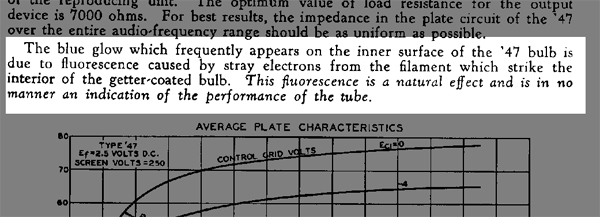 |
|
2) FLUORESCENCE 'Type2'I just call it like that, because I don't exactly know what causes it. This is a brighter color blue glow, but not of high intensity. It has the same color as gassy tubes have, but it's not gas. It appears on the inside of the plates, when the plate current is relatively high. Tubes that you can clearly look inside, like DHT triodes often have it. It appears only on the plate surface, inside the plates. When you look inside with a watch makers lens (the one you put on your eye) you can see that the grid pattern is projected on the plate. Now here comes the interesting part... When the tube warms up it disappears after some minutes. When the tube cools down it comes back, but for that it needs to rest for several weeks. I have seen it with NOS tubes, with new production and with used ones, and it appears with just a few percent of the tubes. I will try to place some pictures of it later. Alesa Vaic had some theories about it, but no real good explanation that I think was true. Most of his AV8 tubes did so, and these have always had very good reliability. Also other people from tube factories I asked, but the more specialists you ask, the more different answers you get. They all agree on one: It doesn't harm the tubes. |
|
3) REGULATOR AND VOLTAGE REFERENCE TUBES.
|
|
4) MERCURY RECTIFIERS.
|
|
5) THYRATRON TUBES.
Thyratrons only few know how to use them. That is because learning theory is regarded a waste of time, reading data sheets is avoided, and no pre-chewed schematics in the internet for copying. That makes them CHEAP :))) But..... they are the best rectifiers ever, and they look great, because they light up so nicely. |
|
6) GASSY TUBES / Part 1Gassy tubes produce a white-blue haze, of low brightness, inside the Anode. You can best see it, when looking from the top, inside the tube. The brightness is much less than the filament lighting.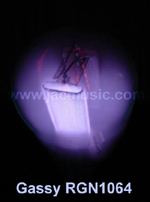
You can only see it in a dark room, and it appears as a uniform cloud, no spot building. It is this kind of blue glow that indicate the vacuum is not as good as can be. The electrons on their way from the Cathode to Anode hit gas molecules, that get ionized from the incidents. The recombination of Ions and Electrons produce the light effects. The Gas ions are much heavier than electrons, and hit the Cathode with a considerable about of energy. This causes early wear-out of the cathode, and grid current if it gets worse. The tube will self destroy eventually. I once bought some rectifier tubes from a respectable gentleman who was at an audio fair in Germany, with his wife, selling off stuff they didn't need anymore. Well, I was lucky to buy the only gassy historical rectifier I had ever seen. He was probably so glad he fooled me with that - and me too :) They get a place in my collection of very rare and hard to find tubes. Here are some pictures of them. With the other tube I heated up the getter, not putting the tube under current. The tube stayed unchanged. From this tube the pictures were made. So for some part, I was successful, but they are still gassy. Pictures by Frank Euler. Thank you Frank! |
|
GASSY TUBES / Part 2I have no pictures of this, but I have seen gassy 302B mesh tubes from Alesa Vaic, giving extremely bright yellow effects on the tube base. It didn't short the tube tester. Alesa took them back right away, and they disappear in his factory before I could picture them. Only saw it with once with a 302B mesh. |
|
GASSY TUBES / Part 3This is a nice one. What you see here is a NOS TESLA ECC802S that has a lot of gas, AND a broken filament. P.s. don't think these are bad tubes, TESLA NOS is the best that you can get. This a handling damage, I dropped it on the floor myself. A glass crack along one pin was the result and it had broken filament also. What is interesting, this tube was unused, and the emission of the TESLA ECC802S is very strong normally. So it was possible to do something with this tube still, though it has an open filament!. It was really interesting to see the self-heat effect with a gassy tube, without any filament function at all! It actually is possible to start up a neon lamp without filament glow too ( with static electricity). Nothing New.... . Many people who see some faint blue light on the plate of their tubes, immediately start to post on the tube forums about their gassy tubes. Well of course this is 99% of the talk about 1% of the problems. Most (99%) tubes with blue light are in perfect condition, it is just fluorescent light as described above. But HERE you see actually a real GASSY tube, pictured in the daylight. So it lights nicely, and very bright blue. |
|
GASSY TUBES / Part 4Update about FULLMUSIC TUBES 11.9.2006
|
|
GASSY TUBES / Part 5Another date about FULLMUSIC TUBES 11.9.2006
|
|
This is what the Emission Labs factory manager says about it:If a tube is ideally constructed, and build from cleanest materials available, it will definitely NOT have a blue FLUORESCENT glow. Trying to make such a tube is no requirement. Historical mixtures of Barium filament coatings used small fractions of radioactive materials, such as Strontium. The use of such materials can easily cause blue glow effects. We never used this type of coating from the beginning. Even without using this material, a tube can have blue glow. There is a very wide range, where absolutely good tubes will have a blue FLUORESCENT glow, and they're perfect products in every respect. This not to be confused with a gassy tube of course. This is what Western Electric says about it:
|
|
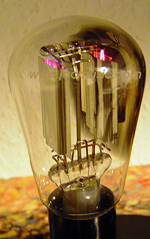 Click here to Enlarge |
This is a report about an attempt to REPAIR a gassy tube, using an historical method - very rough. They used to take the tube out of the socket, and burn the getter with a flame, until the glass almost melts. It destroys the getter, and when it crisps off, the tube was repaired. Interesting... I tried it on this Telefunken RGN1054. I could make this almost dead tube test 'good' again, but not get the gas away. Here is the result.
|
Gassy tube repairPart1 |
|
Gassy tube repairPart 2 |
|
Gassy tube repairPart 3
With this rectifier I tried it, and yes it worked! I didn't heat the getter very much, but enough to burn a dark spot in it. For heating I used a heat fan, as used for shrink sleeve. It gets very hot, and can almost melt glass. So, an ideal tool for this. I did the heating while running it on a Funke W19. A lot of the getter material is now everywhere on the glass also, but not a silver getter, it looks more like dirt. Like the black dirt from very much used tubes. While doing so, the plate current went up from 10mA to 45mA. This means the tube tests 'good' again. But.... the tube is still gassy. In fact the blue light has increased a lot. It cannot be used, the gas ions would destroy the filaments after some time. So it cannot be considered repaired by this. Perhaps when heating the getter up further, and making it crisp off as 1930 literature suggests, the gas will go away. I will not try, I am afraid the glass will break from it, and I loose this nice tube. |
|
Gassy tube repairPart 4 Now what is interesting is, when you FORCE 100mA through this gassy tube, the blue cloud starts to grow, first coming a little bit outside of the plate at voltages above 100Volts. Then, the cloud grows bigger as the current gets larger, and at full 100mA the cloud sort of doesn't fit inside the bulb anymore. So it lays itself on the glass everywhere, and the glass lights up nicely from it. The color is not displayed so well by the night pictures. Only the left diode is under power, but the cloud is so large now, it has grown all inside the tube everywhere, even covering the right diode also. This a a very amazing effect. Obviously this cloud is ionized, and the ions distract each other which makes the cloud grow so large. So the cloud can come out of the plates, or grow so large it even touches the glass. If that happens, via the glass the ions will recombine with electrons again. So the glass is where they like to go. |
|
This is not a blue glow picture. This is NOT a gassy tube with blue light. So what is it...?
I have an old FUJI Camera, first generation digital camera, worth 3 Euro in Ebay. So before throw it away, I tried what happens of I remove the Infra red blocker filter from the camera chip. The result was amazing. The camera has a strong sensitivity for everything that glows dark red, since that produces also a lot if Infra Red. The color of this appears in pink as you can see here. So it is invisible light for us humans, but in the camera it appears to activate the blue and red sensors. Giving pink color. I used no IR pass filter on the camera, so the normal visible light is there also. I don't know yet how to get meaningful information from such pictures, so far it gives just a lot of pink color when picturing tubes. So this is a normal, good mesh tube (Emission Labs 300B-Mesh) with only the heater is turned on. Since the picture reminded me so much of a gassy tube, I decided to show it here. Here is an IR picture in the dark, of my solder iron. Here is how it comes out of photoshop after 'auto correct'. |
|
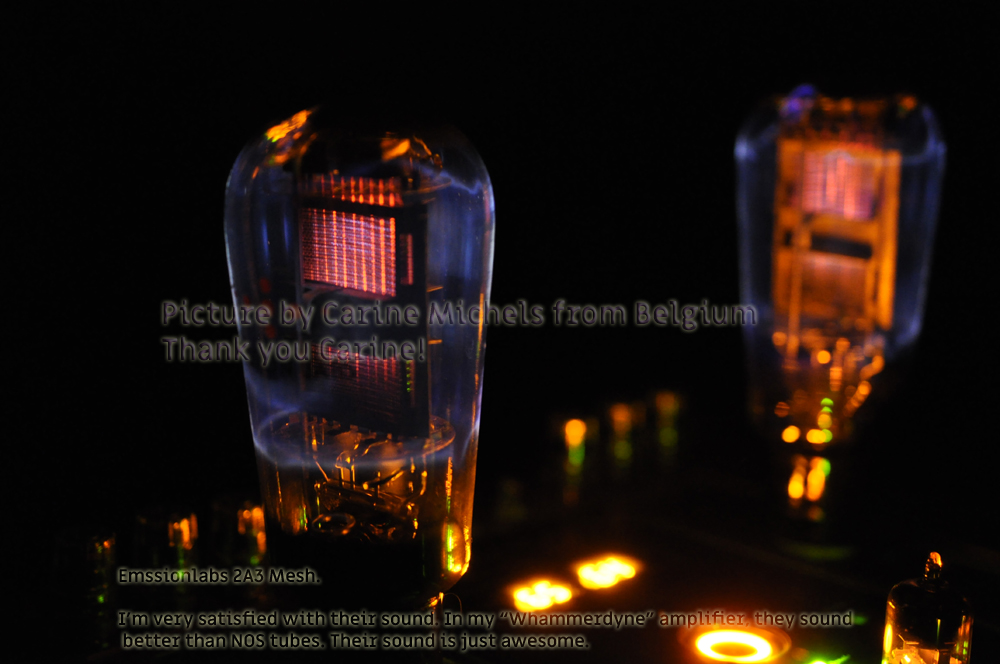
Picture of Emissionlabs 2A3-Mesh placed here, with kind permission of Carine Michels from Belgium. Thank you Carine!

This is a 6W6
pentode, with blue fluorescent glow in the plate, night picture

The same tube in daylight.
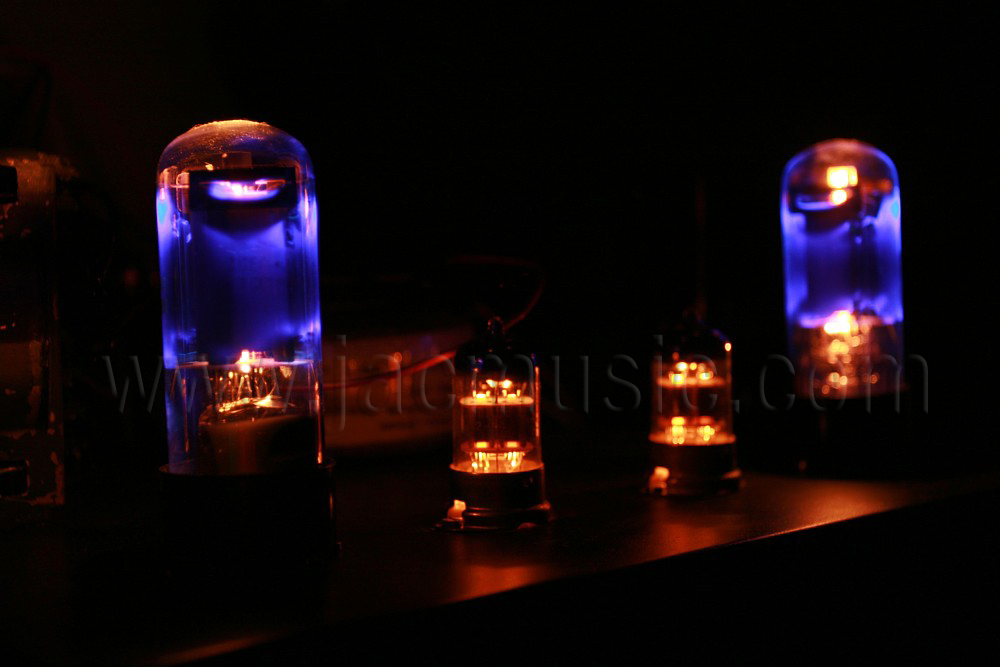
Picture by Marius Stroe. Thank you Marius!
Attached a little 'gift': a picture with 6P3S glowing in the dark. The tubes were brand new and eventually they lost their blue light.
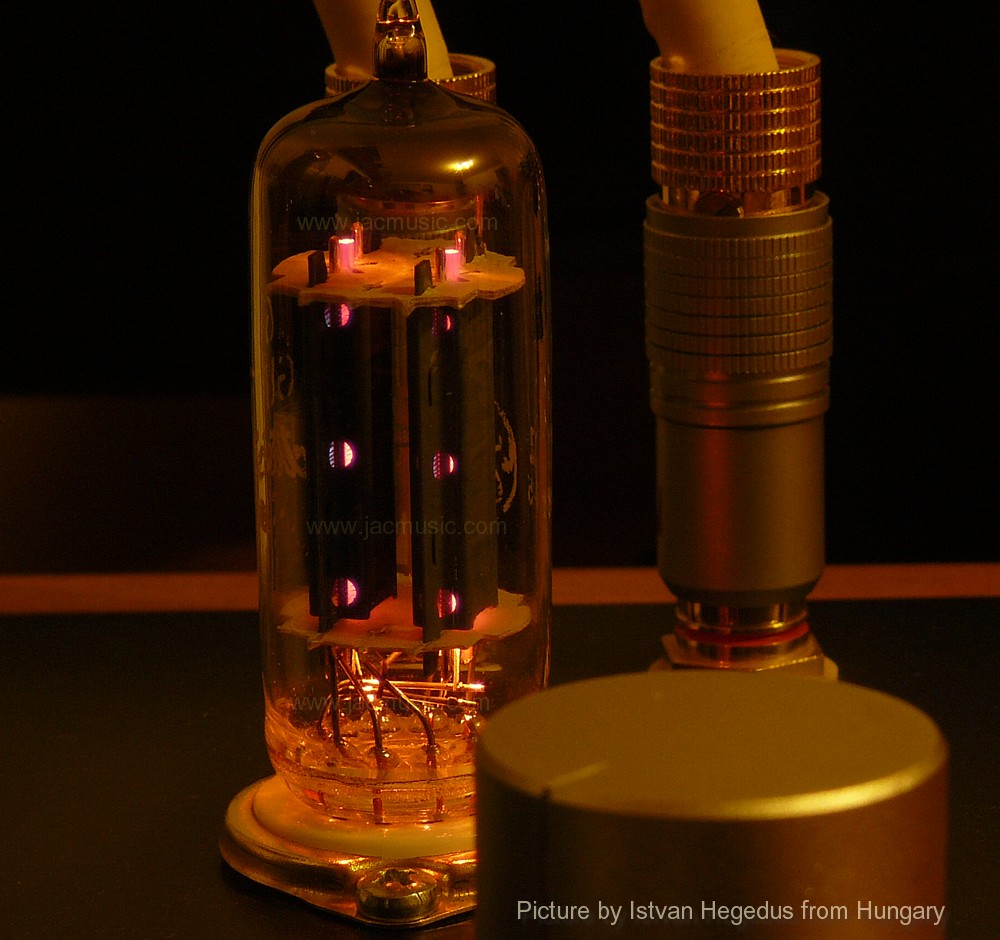
This is a GR 6CG7 as the driver stage in a 2A3 amplifier. This is a nice example for blue glowing. This is the 'Type 2' fluorescence. Thank you Istvan for sending this picture!
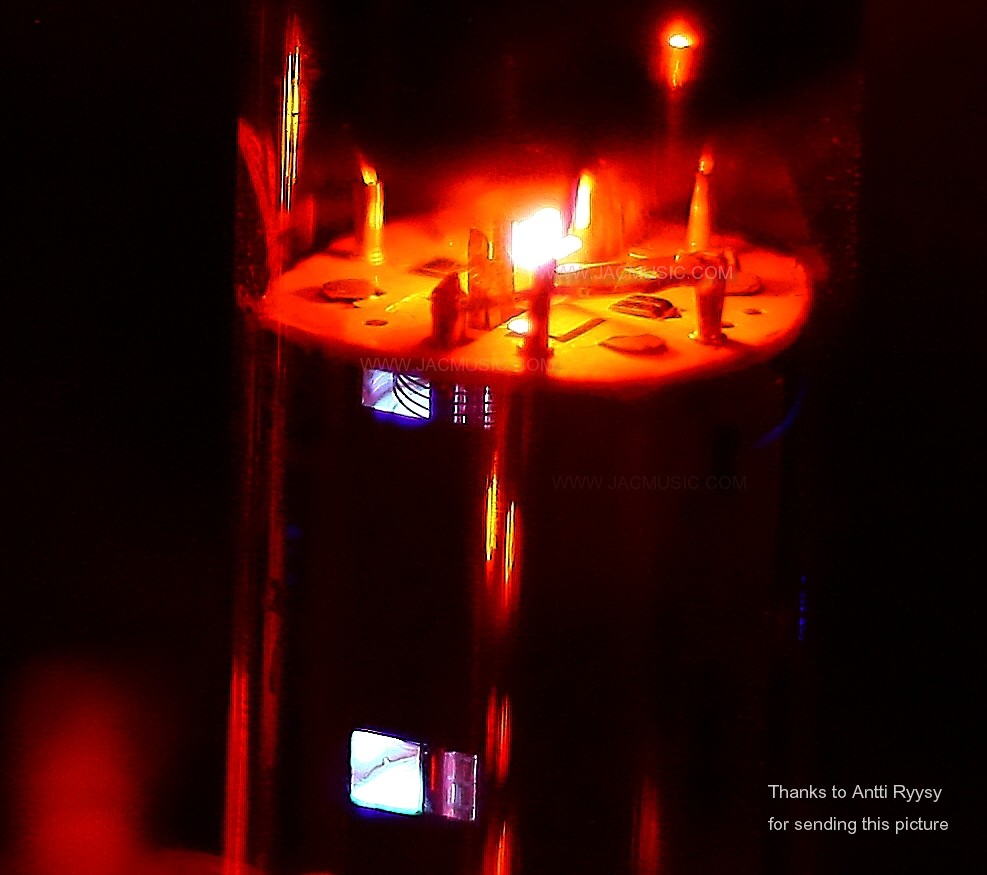
This is 6P14P-EV NOS. Inside you see the fluorescent glow (Type2) on the anode inside. This is not gas. The light effect in reality is lower, because this a long exposure. This Magnificent Picture was send by Antti Ryysy. Thank you Antti!
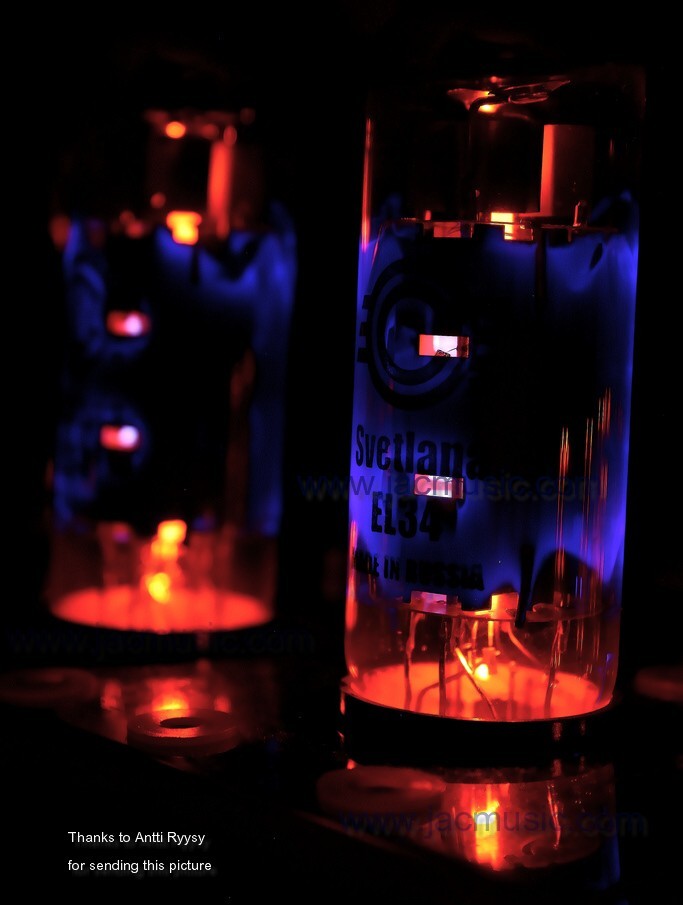
This is the new production Svetlana Winged =C=, with fluorescent glow (Type1)
A Magnificent Picture by Antti Ryysy
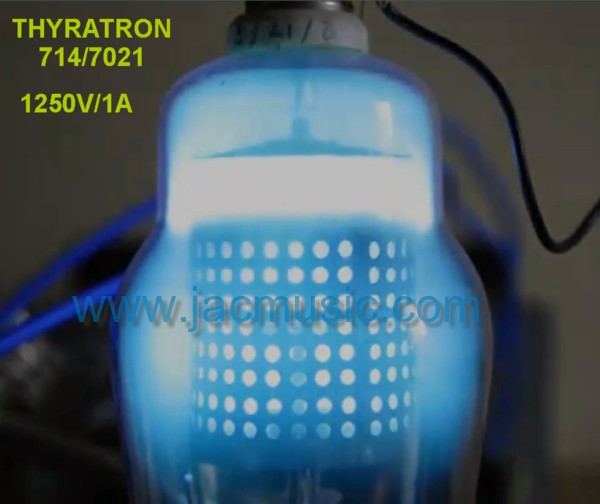
This picture was send by Luiz Amaral who lives in the USA. Thank you Luiz!
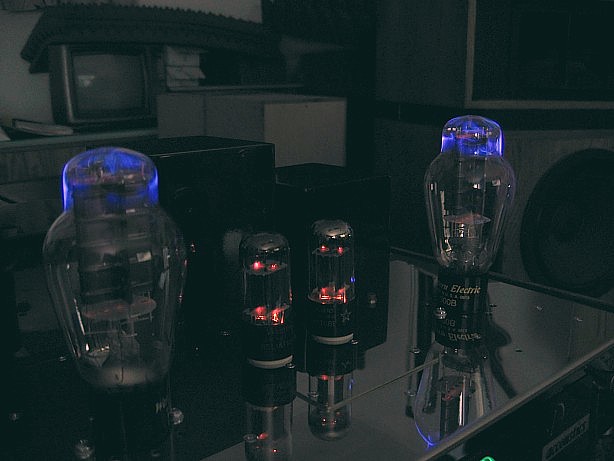
Western Electric 300B, BLUE GLOW. Picture by Dubiel 'Lampomaniak' from Polen. Thanks!
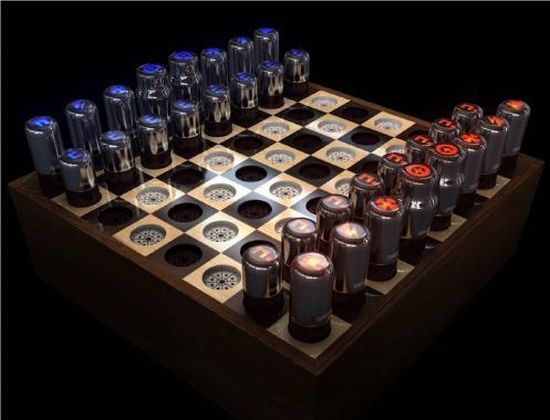
This chess board was build by Paul Fryer. Wow!

Philips AX50 Mercury Rectifier. One Diode with DC current, lighting up blue-white. The other just glowing.

This is a pair of Electro Harmonix 6L6 in an all restored 1954 Seeburg Juke Box
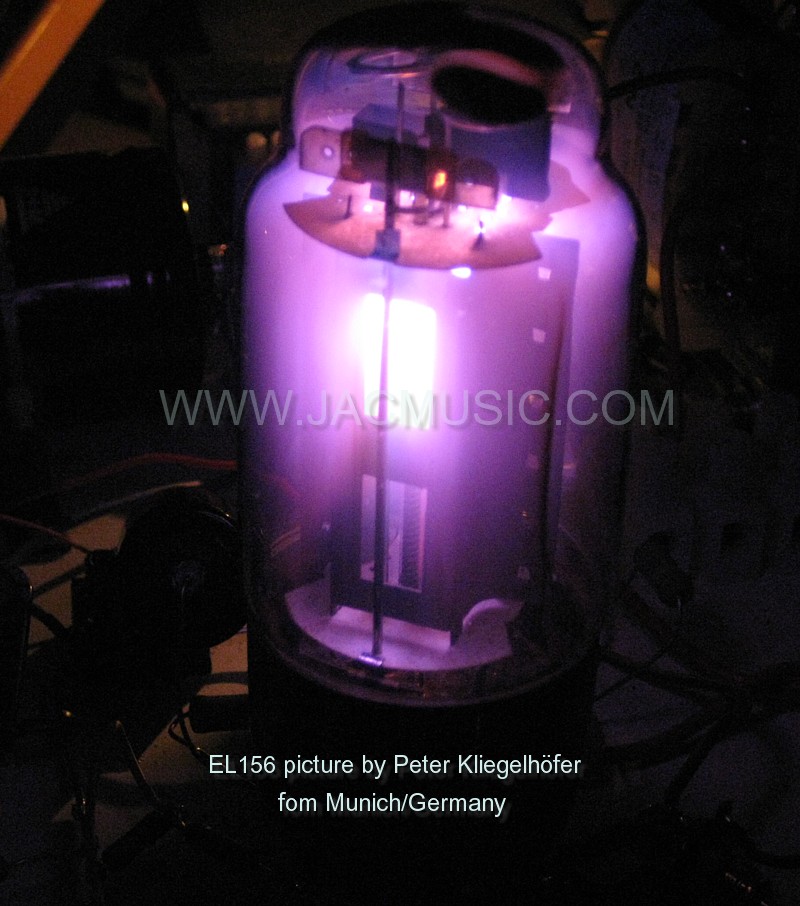
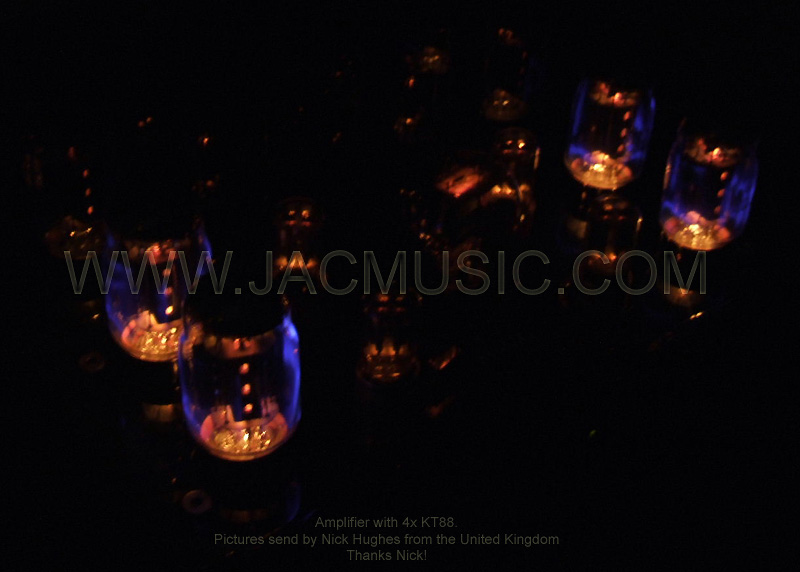
Amplifier with 4x KT88. Picture send by Nick Hughes from the UK.
Thanks Nick!

This Svetlana 6550 is re branded 'Audiomat'. It is a gassy tube.
Pictures by Tomáš Matoušek from the CZ Republic. Thanks Tomáš!

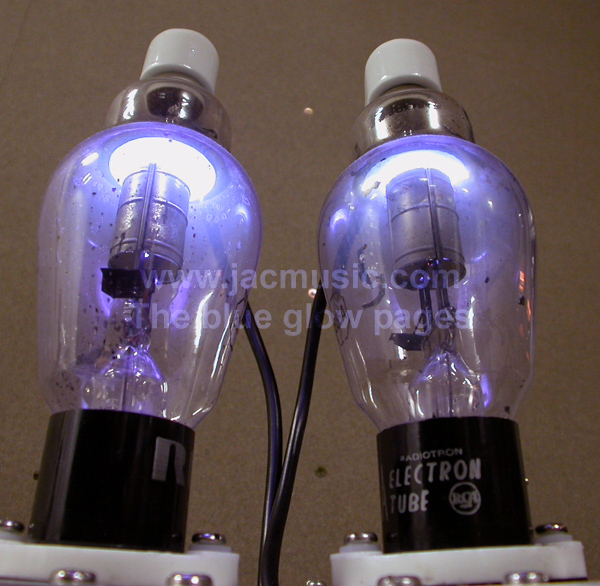
866A tubes, seen at the Triode Festival, Langenargen, Germany
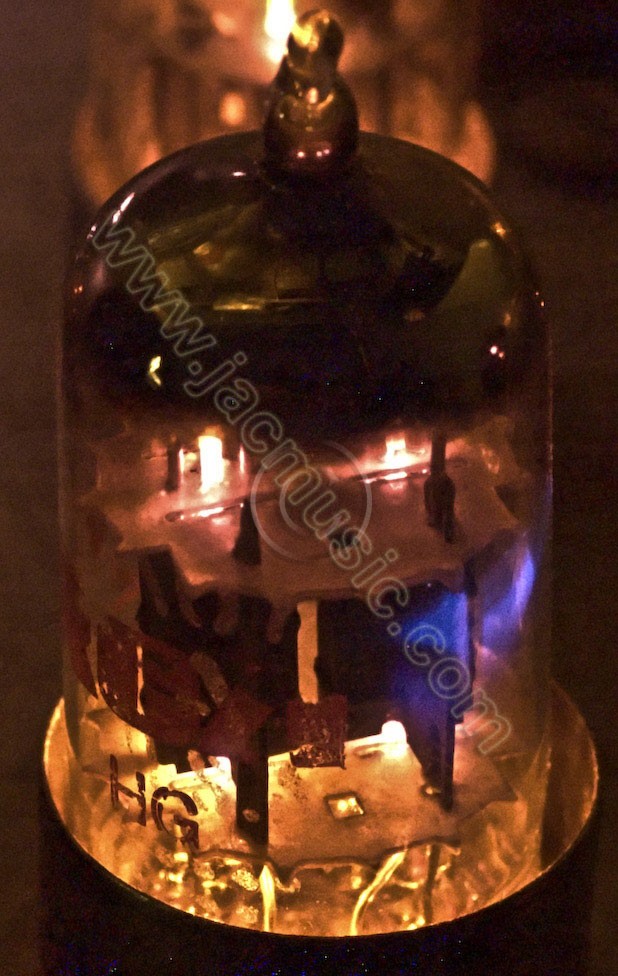
Here is an example of the blue glow in a 12AU7W operating in a Hammarlund
SP-600JX Short wave receiver. This image is HDR (high dynamic range). The
blue glow is all but invisible to the naked eye. This tube is ok, it is only some effect
on the glass surface. No gas inside. Thanks Shaun!
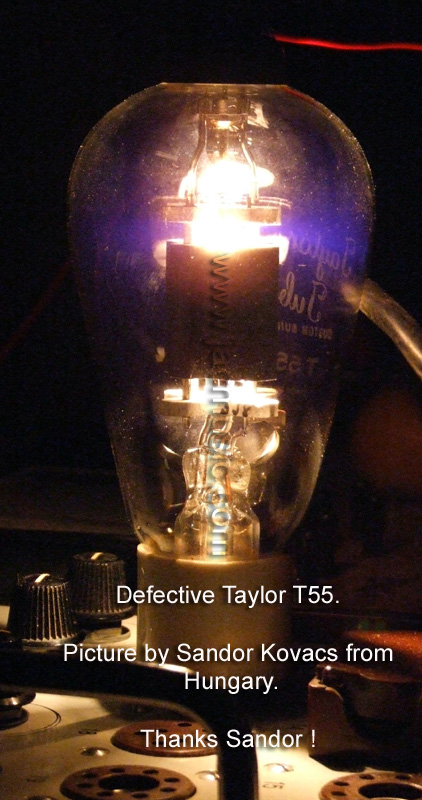

These are TESLA EL34, working in a JADIS amplifier
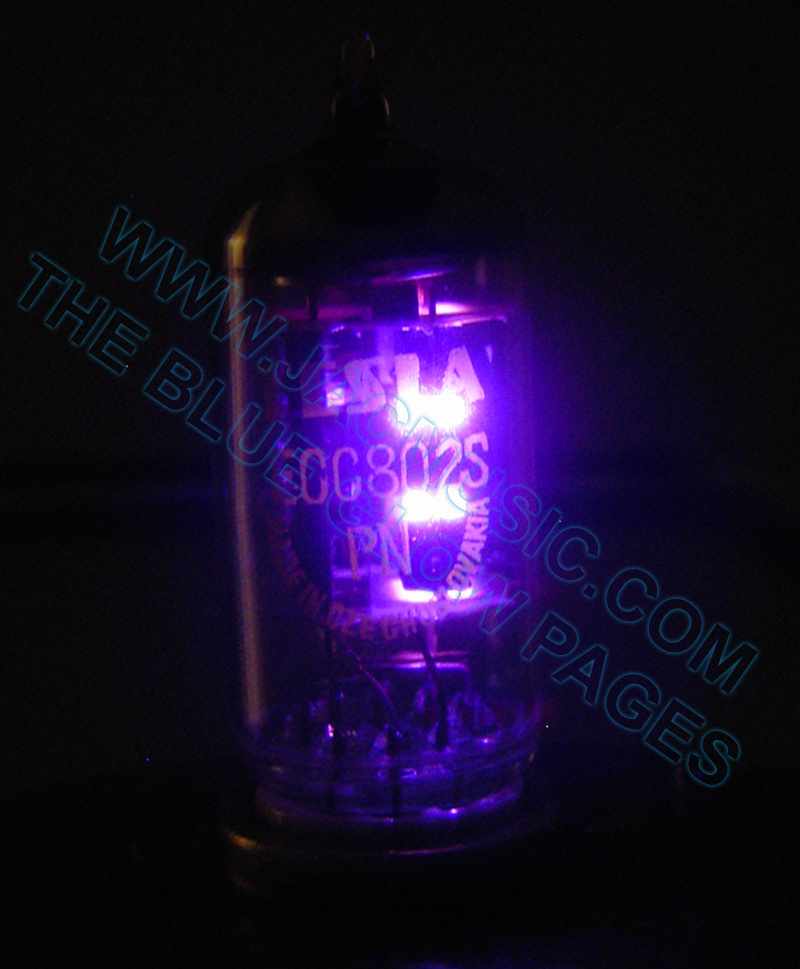
This is a gassy TESLA ECC802S tube, that I bought it on Ebay. It was from the days
when I hoped to buy good tubes from people that sell 'untested' tubes from their
fathers who all passed away, and owned radio stores. Oh.. I was so stupid to believe that

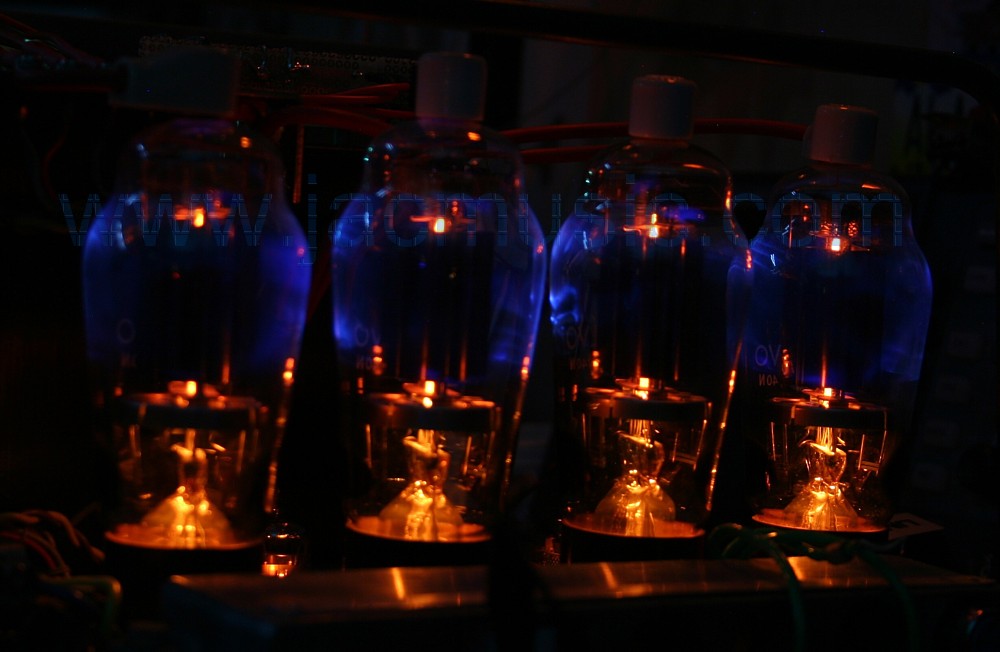
Thanks to Bodo Schreiber from Germany, for this picture of his fully restored Philips EL6435 Amplifier.
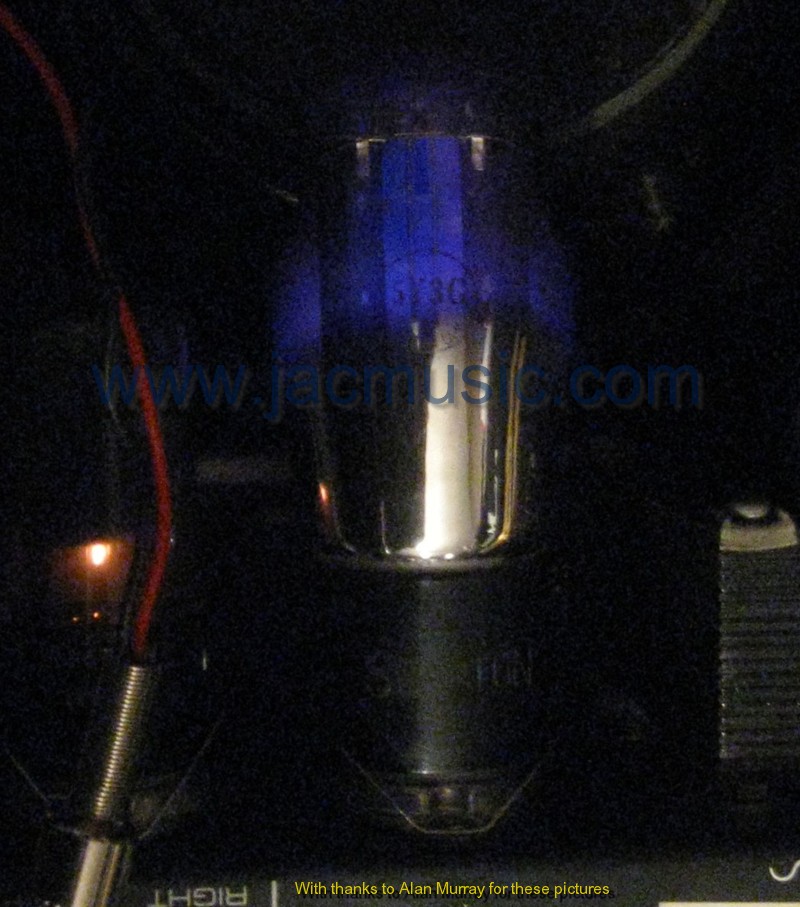
This is a gassy tube 5Y3G in a home built 5E3 guitar amplifier (picture1)

This is a gassy tube 5Y3G in a home built 5E3 guitar amplifier (picture2)
This one I bought on a radio ham show im Germany, from an fine old gentleman, who knew a lot about tubes, and he said this tube was very good. Well, I see him every year there. So we are going to meet there again and discuss this fuc*** fraud of him. When he knows so much about it, I suppose he has a tube tester?
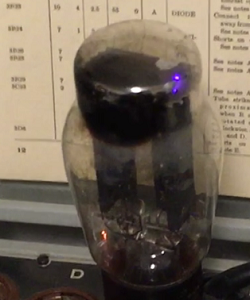 This is video of a gassy 5U4G on my Hickok I-177 tester.
This is video of a gassy 5U4G on my Hickok I-177 tester.
As you can see in the video, at switching on the heater only, the fuse lamp begins to glow, indicating the heater draws far too much current. This higher current is caused by the gas, cooling down the heater a somewhat. So the metal temperature and resistance becomes lower than normal. This tube is on the edge of working at all. So when a tube has lost vacuum completely (which is not so here) the heater current becomes even much higher, and of course the tube tester will not respond to the 'test' button any more. It does respond however here. The reading is even strong, but the tube sparkles. The reading is good, forward resistance of a gassy tube is much lower. Only, at some point they also begin to conduct in the reverse direction. If that point becomes in reached, the amplifier fuse will blow at switch on, and the tube will flash frightening bright. At the next start, the tube probably works again by coincidence, but not for long, because the gas by itself causes more gas. During normal use, always some metallic Barium gets evaporated from the cathode. Very little, and very slow, but it happens. Then, Barium oxide from underneath appears at the open spots. This gets reduced by the cathode current, in a so called REDOX reaction, and the result is new metallic Barium, and oxygen gas. So the open spot self repairs, and the oxygen gas molecules get absorbed by the Getter. The Gas oxygen gas molecules on their way to the getter however get bombarded by electrons, and get ionized. (So they loose their electrons and become positively charged ioins) Unfortunately in this condition, the get attracted by the negative voltage of the cathode, and hit it violently. This shoots new holes in the cathode layer, which however will also self repair. After scattering around in the tube, eventually the gas molecules are trapped by the getter. This is a slow process, taking place in all tubes, and it determines the lifetime of the tube, for as long as the getter lasts. This gas is either it is caused by leakage, or by normal wear out. With new made Russian tubes, some small leakage is almost normal, it is really a shame. After some years, such initially good tubes may slowly turn bad, and even no customer is angry. What a business model. With historic tubes, gas problems are only related to very long use, and not to age.

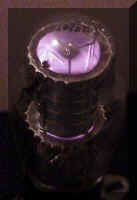 These tubes are quite high vacuum , but there is a residue of gas added to the tube, on purpose. They light up pink, violet, or orange, depending on the used gas, like Krypton, Neon, etc. Gas filled tubes can be voltage references or voltage regulators. A common reference was the OB2. Forgotten is, that these devices had a 100x lower temperature drift compared to Zener diodes. When these are put in an 'Oven', which were special boxes that keep the inside temperature constant, your get a voltage reference that is stabile at the 5th digit easily.
These tubes are quite high vacuum , but there is a residue of gas added to the tube, on purpose. They light up pink, violet, or orange, depending on the used gas, like Krypton, Neon, etc. Gas filled tubes can be voltage references or voltage regulators. A common reference was the OB2. Forgotten is, that these devices had a 100x lower temperature drift compared to Zener diodes. When these are put in an 'Oven', which were special boxes that keep the inside temperature constant, your get a voltage reference that is stabile at the 5th digit easily. 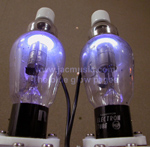
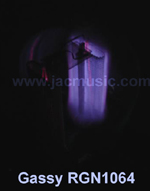
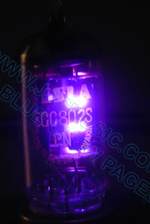
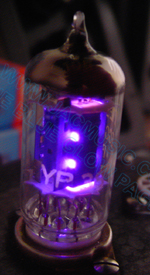
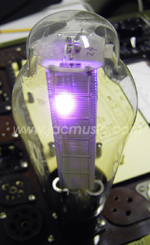
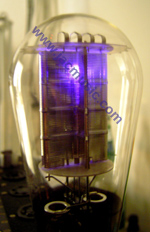
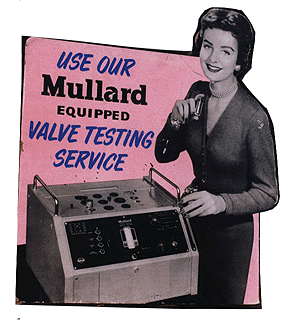 'A blue glow may appear in the dome of the WE300B just below the upper mica and the top edge of the plate. The space between the plate and glass is small at this point (less than 1/8 in.) and appears to be the only area of the tube where this phenomenon takes place. The glow is caused by the electrons striking the plate, violating the surface, and dislodging atoms of nickel. High speed barium-strontium electrons from the filament collide with the atom, tearing off electrons, ionizing them and causing a deep blue color even in a well evacuated tube. The glow is a function of the plate voltage and the number of gas molecules in the envelope. In a good vacuum there are still billions of molecules. The electrons do not cause trouble because they all return to the positively charged plate. The size of the glow also varies with plate voltage and is not the same for each tube: it can vary from not discernible to very obvious even in daylight. It does not affect tube performance as can be shown by observing the characteristic curves during tube operation'
'A blue glow may appear in the dome of the WE300B just below the upper mica and the top edge of the plate. The space between the plate and glass is small at this point (less than 1/8 in.) and appears to be the only area of the tube where this phenomenon takes place. The glow is caused by the electrons striking the plate, violating the surface, and dislodging atoms of nickel. High speed barium-strontium electrons from the filament collide with the atom, tearing off electrons, ionizing them and causing a deep blue color even in a well evacuated tube. The glow is a function of the plate voltage and the number of gas molecules in the envelope. In a good vacuum there are still billions of molecules. The electrons do not cause trouble because they all return to the positively charged plate. The size of the glow also varies with plate voltage and is not the same for each tube: it can vary from not discernible to very obvious even in daylight. It does not affect tube performance as can be shown by observing the characteristic curves during tube operation'